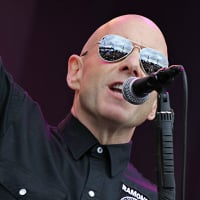Capitol Hill Riots
Comments
-
‘Viking Guy’ granted all-organic diet in custody after judge learns he’s not eating
https://nationalpost.com/news/world/viking-guy-granted-all-organic-diet-in-custody-after-judge-learns-hes-not-eating?utm_source=Facebook&utm_medium=organic_fb_tw&utm_campaign=broadsheet_promo&fbclid=IwAR0t3vaGR769fKGgxnl7iue-z-YCeBjvcREVQiTqDAn97xw-N5W1OY4RU1g#Echobox=1610488379
Poor baby...
Give Peas A Chance…0 -
Isn't that what they like to call a snowflake.Meltdown99 said:‘Viking Guy’ granted all-organic diet in custody after judge learns he’s not eating
https://nationalpost.com/news/world/viking-guy-granted-all-organic-diet-in-custody-after-judge-learns-hes-not-eating?utm_source=Facebook&utm_medium=organic_fb_tw&utm_campaign=broadsheet_promo&fbclid=IwAR0t3vaGR769fKGgxnl7iue-z-YCeBjvcREVQiTqDAn97xw-N5W1OY4RU1g#Echobox=1610488379
Poor baby...
0 -
the face of the insurrection and republican "strength" can't handle a tv dinner. oh how rich this is.Your boos mean nothing to me, for I have seen what makes you cheer0
-
great....
Police warn of new plot for 4,000 armed insurrectionists to surround US Capitol
https://www.yahoo.com/news/police-warn-plot-4-000-211420708.htmlPolice have warned of a plot in which 4,000 armed insurrectionists could descend on Washington in the coming days, encircling the US Capitol.
It was one of at least three armed plots detailed in a phone call between US Capitol Police and Democrat members of Congress, according to politicians on the call.
Meanwhile, it emerged that the FBI had warned extremists were planning for "war" the day before the storming of the Capitol on Jan 6.
FBI agents were aware that plotters had shared maps of the tunnels under the Capitol online, and arranged locations to rendez-vous in states including Kentucky and South Carolina before heading to Washington.
But still the National Guard was not called in beforehand.
The disclosure came as 15,000 National Guard troops were activated to protect the Capitol in the lead up to Joe Biden's inauguration on Jan 20.
Following requests from Democrats some National Guard members were being subjected to additional background checks to ensure they were not "sympathetic to domestic terrorists."
Chuck Schumer, the Democrat leader in the Senate, called for anyone in the mob that entered the Capitol on Jan 6 to be put on a no-fly list to stop them returning to Washington ahead of the inauguration.
He said: "We cannot allow these same insurrectionists to get on a plane and cause more violence and more damage."
Donald Trump declared a state of emergency in Washington and the city's Democrat mayor, Muriel Bowser, pleaded with Americans to stay away.
The FBI warned of armed protests at all 50 state Capitols in the coming days, and security was beefed up at government buildings across the country.
In a police phone call with members of Congress on Monday night politicians were taken through specific threats being made ahead of the inauguration.
One plot outlined by police was described as the "largest armed protest ever to take place on American soil."
Another was a protest planned to remember Ashli Babbitt, who was shot dead during the invasion of the Capitol last week.
A third would see thousands of armed people surrounding Congress to stop Democrat politicians from going in, which could result in assassinations.
Extremists might also surround the US Supreme Court and the White House, politicians were told.
Rules of engagement were being drawn up for how the National Guard should deal with armed insurrectionists.
Conor Lamb, a Democrat congressman from Pennsylvania, and former US Marine, who was on the phone call with police, said: "They were talking about 4,000 armed 'patriots' to surround the Capitol and prevent any Democrat from going in.
"They have published rules of engagement, meaning when you shoot and when you don't. So this is an organised group that has a plan."
He added: "They [insurrectionists] are committed to doing what they're doing because I think in their minds they are patriots and they're talking about 1776 and so this is now a contest of wills.
"We are not negotiating with or reasoning with these people. They have to be prosecuted. They have to be stopped. And unfortunately, that includes the president, which is why he needs to be impeached and removed from office. "The threats we are facing are very specific."
The internal FBI warning before Jan 6 was issued after agents picked up online chatter.
It included comments such as "Be ready to fight. Congress needs to hear glass breaking, doors being kicked in, and blood from their BLM and Pantifa [Antifa] slave soldiers being spilled.
"Get violent. Stop calling this a march, or rally, or a protest. Go there ready for war. We get our President or we die. NOTHING else will achieve this goal."
However, the memo, which was immediately passed to the FBI in Washington, also suggested that the words were protected by the First Amendment right to free speech.
I'll ride the wave where it takes me......0 -
Gas em!The love he receives is the love that is saved0
-
0
-
Are they going to cut the crust off of his sandwiches as well?Meltdown99 said:‘Viking Guy’ granted all-organic diet in custody after judge learns he’s not eating
https://nationalpost.com/news/world/viking-guy-granted-all-organic-diet-in-custody-after-judge-learns-hes-not-eating?utm_source=Facebook&utm_medium=organic_fb_tw&utm_campaign=broadsheet_promo&fbclid=IwAR0t3vaGR769fKGgxnl7iue-z-YCeBjvcREVQiTqDAn97xw-N5W1OY4RU1g#Echobox=1610488379
Poor baby...0 -
Joint Chiefs of Staff call Capitol riot 'sedition and insurrection,' remind troops of oathTom Vanden Brook USA TODAY WASHINGTON – The Pentagon’s senior military leadership on Tuesday branded the riot Jan. 6 at the Capitol “sedition and insurrection” and admonished troops to heed their charge to protect and defend the Constitution “against all enemies, foreign and domestic.” The extraordinary memo to all active duty and reserve troops left no doubt that the military’s top brass considered last week’s attack on the Capitol to be a criminal act and counter to military values and their oaths. Army Gen. Mark Milley, the chairman of the Joint Chiefs of Staff, signed the memo along with seven other senior leaders. “We witnessed actions inside the Capitol building that were inconsistent with the rule of law,” the chiefs wrote. “The rights of freedom of speech and assembly do not give anyone the right to resort to violence, sedition and insurrection.“As Service Members, we must embody the values and ideals of the Nation. We support and defend the Constitution. Any act to disrupt the Constitutional process is not only against our traditions, values, and oath; it is against the law.” The Pentagon is seeking to determine how many troops may have taken part in the riot, which took place after President Donald Trump whipped up the crowd. The Army has found that an Army Special Forces captain was at the Capitol and is investigating what she did there. The attack and its aftermath left five people dead and occurred as Congress met in joint session to formalize the Electoral College victory of President-elect Joe Biden.“The violent riot in Washington, D.C. on January 6, 2021 was a direct assault on the U.S. Congress, the Capitol building, and our Constitutional process,” they wrote. “We mourn the deaths of two Capitol policemen and others connected to these unprecedented events.” DC National Guard walk around the Capitol grounds, Jan. 7, 2021 in Washington. Since demonstrations this summer after the death of George Floyd, a Black man, at the hands of a white Minneapolis police officer, Milley has sought to insulate the military from Trump’s attempt to enlist it in his political fights. Milley and former Defense Secretary Mark Esper fought successfully to keep Trump from invoking the Insurrection Act, which would have allowed him to deploy active duty troops on American streets. In the runup to the election, Milley repeatedly stated that the military had no role in electoral politics. The chiefs closed by noting that Biden will be inaugurated Jan. 20 and called on troops to remain focused on their missions. The Pentagon was asked to review all members of the security detail for Biden's inauguration Jan. 20 to ensure they are "not sympathetic to domestic terrorists," Rep. Jason Crow, D-Colo., said.Post edited by mickeyrat on_____________________________________SIGNATURE________________________________________________
Not today Sir, Probably not tomorrow.............................................. bayfront arena st. pete '94
you're finally here and I'm a mess................................................... nationwide arena columbus '10
memories like fingerprints are slowly raising.................................... first niagara center buffalo '13
another man ..... moved by sleight of hand...................................... joe louis arena detroit '140 -
So if these deplorable Americans show up on the 20th armed to the teeth will the reserve’s fight them off? Wouldn’t that constitute the start of a civil war?jesus greets me looks just like me ....0
-
I think it would be considered an insurrection...not that insurrections haven’t led to civil wars in the past...but I don’t think we are on the brink of a civil war just yet.josevolution said:So if these deplorable Americans show up on the 20th armed to the teeth will the reserve’s fight them off? Wouldn’t that constitute the start of a civil war?I would consider this more of a trailer trash uprising (nothing against those that reside in trailer houses).Post edited by PJPOWER on0 -
I live in Saint Paul, a capital city. I will not be going anywhere near that building from the 17th to the 21st. Thankfully I don’t really have that much to do these days anyway1995 Milwaukee 1998 Alpine, Alpine 2003 Albany, Boston, Boston, Boston 2004 Boston, Boston 2006 Hartford, St. Paul (Petty), St. Paul (Petty) 2011 Alpine, Alpine 2013 Wrigley 2014 St. Paul 2016 Fenway, Fenway, Wrigley, Wrigley 2018 Missoula, Wrigley, Wrigley 2021 Asbury Park 2022 St Louis 2023 Austin, Austin 2024 Napa, Wrigley, Wrigley 2025 Nashville (II)0
-
yeah, i don't even know what has to happen in order for it to be an "official" civil war. i would imagine at least one whole state would have to declare itself sovereign or it's governor (or trump) were actually the "true" president or something. I don't know. I don't know really anything about the american civil war.PJPOWER said:
I think it would be considered an insurrection...not that insurrections haven’t led to civil wars in the past...but I don’t think we are on the brink of a civil war just yet.josevolution said:So if these deplorable Americans show up on the 20th armed to the teeth will the reserve’s fight them off? Wouldn’t that constitute the start of a civil war?I would consider this more of a trailer trash uprising (nothing against those that reside in trailer houses).Your boos mean nothing to me, for I have seen what makes you cheer0 -
Klepper has some brass ones.GlowGirl said:0 -
The video posted here showing the bawling guy kicked off a plane was evidently NOT Capitol relayed and not No Fly due to insurrection related.
It was no mask wearing related.
Fuck I hate the internet sometimes. Gotta check everything because so many people are completely full of shit.
https://www.newsweek.com/viral-tiktok-video-twitter-man-kicked-off-flight-following-capitol-riots-dc-1560473The love he receives is the love that is saved0 -
0
-
_____________________________________SIGNATURE________________________________________________
Not today Sir, Probably not tomorrow.............................................. bayfront arena st. pete '94
you're finally here and I'm a mess................................................... nationwide arena columbus '10
memories like fingerprints are slowly raising.................................... first niagara center buffalo '13
another man ..... moved by sleight of hand...................................... joe louis arena detroit '140 -
It’s bad, and is it just me, or has there been an influx of fake “shock videos” on the net lately? I think everyone is trying to capitalize on the discourse and are coming up with fake “Karen” incidents, “busted cheating” videos, and fight vids. Most of them are obviously fake, but as long as they keep monetizing “hits”, I think this stuff will just get worse. I just wonder how many watch them and get really riled up...F Me In The Brain said:The video posted here showing the bawling guy kicked off a plane was evidently NOT Capitol relayed and not No Fly due to insurrection related.
It was no mask wearing related.
Fuck I hate the internet sometimes. Gotta check everything because so many people are completely full of shit.
https://www.newsweek.com/viral-tiktok-video-twitter-man-kicked-off-flight-following-capitol-riots-dc-1560473
I mean, all one would have to do is tag “capitol” or “riot” to their videos when news like that is trending, and they reap the benefits...it’s like a different form of “cat fishing”.
I know it’s been happening for years, but just seems way worse now.
Post edited by PJPOWER on0 -
Oh that flimsy floppy Graham needs to be kicked out of senate, I wonder what they ordered for dinner?
https://twitter.com/zeldamc/status/1349218728165187584?s=21
jesus greets me looks just like me ....0 -
You're not wrong, it is definitely getting worse, people are going to extremes to capitalize on the discourse like never before and last Wednesday we reached a boiling point with people who have been manipulated by lies.PJPOWER said:
It’s bad, and is it just me, or has there been an influx of fake “shock videos” on the net lately? I think everyone is trying to capitalize on the discourse and are coming up with fake “Karen” incidents, “busted cheating” videos, and fight vids. Most of them are obviously fake, but as long as they keep monetizing “hits”, I think this stuff will just get worse. I just wonder how many watch them and get really riled up...F Me In The Brain said:The video posted here showing the bawling guy kicked off a plane was evidently NOT Capitol relayed and not No Fly due to insurrection related.
It was no mask wearing related.
Fuck I hate the internet sometimes. Gotta check everything because so many people are completely full of shit.
https://www.newsweek.com/viral-tiktok-video-twitter-man-kicked-off-flight-following-capitol-riots-dc-1560473
I mean, all one would have to do is tag “capitol” or “riot” to their videos when news like that is trending, and they reap the benefits...it’s like a different form of “cat fishing”.
I know it’s been happening for years, but just seems way worse now.0
Categories
- All Categories
- 149.1K Pearl Jam's Music and Activism
- 110.2K The Porch
- 283 Vitalogy
- 35.1K Given To Fly (live)
- 3.5K Words and Music...Communication
- 39.4K Flea Market
- 39.4K Lost Dogs
- 58.7K Not Pearl Jam's Music
- 10.6K Musicians and Gearheads
- 29.1K Other Music
- 17.8K Poetry, Prose, Music & Art
- 1.1K The Art Wall
- 56.8K Non-Pearl Jam Discussion
- 22.2K A Moving Train
- 31.7K All Encompassing Trip
- 2.9K Technical Stuff and Help





 https://youtu.be/YVDJqipoohc
https://youtu.be/YVDJqipoohc





